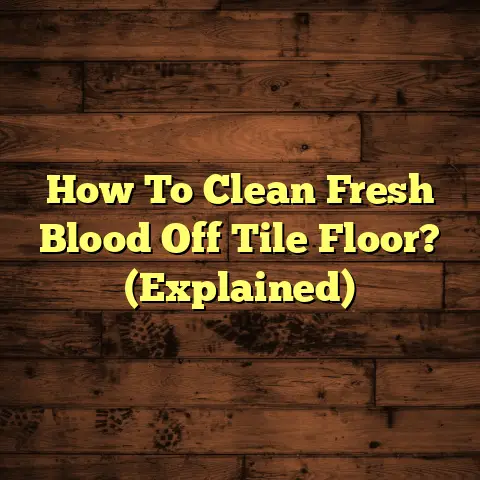Flooded Hardwood? (1st Action Steps!)
Did you know that according to the National Flood Insurance Program, over 20% of flood claims come from properties outside designated flood zones?
That’s right! Water damage can happen to anyone, anywhere, and if you’re a hardwood floor enthusiast like me, that thought can send shivers down your spine.
But don’t panic! I’m here to walk you through the crucial first steps to take when your beautiful hardwood meets unwelcome water.
Let’s dive in!
Section 1: Understanding the Impact of Flooding on Hardwood Floors
Overview of Hardwood Flooring
Hardwood flooring… ah, the epitome of classic beauty and timeless appeal.
We’re talking solid planks milled from a single piece of wood, or engineered options that combine a hardwood veneer with a stable core.
Popular choices include:
- Oak (red and white)
- Maple
- Hickory
- Walnut
- Cherry
Each species offers a unique grain pattern, color variation, and hardness level (measured by the Janka hardness scale).
But here’s the thing: as gorgeous as hardwood is, it’s a natural material.
And natural materials are inherently vulnerable to moisture.
Think of it like a sponge – it soaks up water.
Hardwood floors can absorb moisture from humidity, spills, and, yes, even flooding.
This absorption can lead to a whole host of problems, which we’ll get into next.
The Effects of Flooding on Hardwood
Okay, so your hardwood’s been flooded. What now?
Unfortunately, the effects can be pretty dramatic.
Here’s what you might see:
- Warping: The boards start to bend and lose their flat, even surface.
- Cupping: The edges of the boards rise higher than the center, creating a concave shape.
- Buckling: The boards lift completely off the subfloor, creating humps and waves.
Why does this happen?
Well, wood expands when it gets wet and contracts when it dries.
Flooding causes rapid and uneven moisture absorption, leading to these distortions.
Different types of hardwood react differently to moisture.
For example, softer woods like pine are more prone to water damage than harder woods like maple.
The finish on your floor also plays a role.
A well-sealed floor will be more resistant to water damage than a poorly sealed one.
But let’s be real, no finish is completely waterproof.
The longer the water sits, the more damage it will cause, leading to potential mold growth and rot.
Section 2: Initial Assessment of Flood Damage
Alright, you’ve got a flooded hardwood floor. Before you rush in, let’s prioritize safety and assess the situation.
Safety Precautions
Your safety is paramount. I cannot stress this enough.
Before you even think about stepping into that flooded area, take these precautions:
- Turn Off the Power: Electricity and water do not mix. Shut off the power to the affected area at the circuit breaker to prevent electrocution.
- Wear Protective Gear: Put on waterproof boots, gloves, and a mask. Floodwater can contain bacteria, sewage, and other nasty contaminants.
- Inspect for Structural Damage: Before entering, check for any signs of structural instability, like sagging ceilings or walls. If you suspect structural damage, call a professional immediately.
Visual Inspection
Once you’ve taken the necessary safety precautions, it’s time to assess the damage.
Grab a flashlight and follow these steps:
- Document Everything: Take photos and videos of the flooded area before you start any cleanup. This will be crucial for insurance purposes.
- Look for Obvious Signs of Damage: Check for warping, cupping, buckling, discoloration, and gaps between the boards.
- Sniff for Mold: A musty odor is a tell-tale sign of mold growth. Mold can start growing within 24-48 hours of water exposure.
- Check Underneath: If possible, check the subfloor for moisture and damage. This may require removing a section of the flooring.
Determining the Severity of the Flooding
Understanding the severity of the flooding is crucial for determining the appropriate course of action.
Consider these factors:
- Depth of the Water: How high did the water reach? The deeper the water, the more extensive the damage.
- Duration of the Flooding: How long was the water in contact with the hardwood? The longer the exposure, the greater the risk of warping, cupping, and mold growth.
- Source of the Water: Was it clean water from a burst pipe, or contaminated water from a sewer backup? Contaminated water requires more extensive cleaning and disinfection.
The longer water sits, the more it seeps into every nook and cranny, causing more damage as time goes on.
Section 3: Immediate Action Steps for Flooded Hardwood
Okay, assessment done! Now, let’s get to the nitty-gritty.
Time to take action!
Stop the Water Source
This is the most crucial step.
If the flooding is ongoing, you need to stop the water source immediately.
This might involve:
- Turning off the main water supply to your home.
- Repairing a burst pipe.
- Contacting a plumber or the fire department.
Until you stop the water, you’re just fighting a losing battle.
Remove Excess Water
Once the water source is stopped, it’s time to remove the standing water.
Here’s how:
- Use a Pump: If you have a significant amount of standing water, a sump pump or wet/dry vacuum can be your best friend.
- Mop and Towel: For smaller amounts of water, use mops and towels to soak up as much water as possible. Wring out the mops and towels frequently.
- Consider a Water Extractor: These machines are designed to extract water from carpets and upholstery, but they can also be used on hardwood floors to remove excess moisture.
Drying the Area
Removing the standing water is only the first step. You need to thoroughly dry the area to prevent mold growth and further damage.
Here are some effective drying methods:
- Fans: Place fans strategically around the room to circulate air and promote evaporation.
- Dehumidifiers: Dehumidifiers remove moisture from the air, helping to dry out the hardwood floors and subfloor.
- Natural Ventilation: Open windows and doors to allow fresh air to circulate, weather permitting.
- Remove Baseboards: Removing baseboards can help to improve airflow and allow moisture to escape from behind the walls.
Drying can take several days, or even weeks, depending on the severity of the flooding.
Be patient and monitor the moisture levels regularly using a moisture meter.
Evaluate and Document the Damage
As you’re cleaning up, continue to document the damage.
Take photos and videos of the progress.
Keep detailed records of all expenses related to the cleanup, including equipment rentals, cleaning supplies, and professional services.
This documentation will be essential when filing an insurance claim.
Section 4: Professional Help vs. DIY
Now, let’s talk about whether you can tackle this yourself or if it’s time to call in the pros.
When to Call in Professionals
There are definitely situations where DIY just isn’t enough.
Consider calling in professionals if:
- Extensive Damage: If a large area of your hardwood floor is damaged, or if the damage is severe (e.g., buckling, structural damage), it’s best to consult with a professional.
- Contaminated Water: If the flooding involved contaminated water (e.g., sewage backup), you’ll need professional cleaning and disinfection services.
- Mold Growth: If you see or smell mold, it’s crucial to hire a professional mold remediation company. Mold can be hazardous to your health, and it’s important to remove it properly.
- Lack of Experience: If you’re not comfortable with the cleanup process, or if you’re unsure how to properly dry and restore your hardwood floors, it’s best to leave it to the experts.
Professional flooring contractors have the expertise, equipment, and resources to handle even the most challenging flood damage situations.
DIY Restoration Techniques
If the damage is minor and you’re feeling confident, you can attempt some DIY restoration techniques.
Here are a few ideas:
- Moisture Meter: Use a moisture meter to check the moisture levels in your hardwood floors. Aim for a moisture content of 6-8%.
- Wood Conditioner: Apply a wood conditioner to help restore moisture to the wood and prevent cracking.
- Spot Repairs: For minor scratches and dents, you can use wood filler or touch-up markers to conceal the damage.
- Refinishing: If the finish is damaged, you may need to sand and refinish the affected area.
Remember, DIY restoration is best suited for minor damage. If you’re unsure about any step of the process, it’s always best to consult with a professional.
Section 5: Long-Term Considerations After Flooding
The initial cleanup is just the beginning. You need to monitor the area and take preventative measures to protect your hardwood floors in the future.
Monitoring the Area
After the initial cleanup, keep a close eye on the affected area for any signs of further damage or mold growth.
- Check for Moisture: Continue to use a moisture meter to monitor the moisture levels in your hardwood floors.
- Look for Mold: Inspect the area regularly for any signs of mold, such as discoloration, musty odors, or visible growth.
- Watch for Warping: Check for any changes in the shape or alignment of the hardwood boards.
If you notice any of these signs, take action immediately to address the problem.
Preventative Measures for the Future
Prevention is always better than cure.
Here are some long-term strategies to protect your hardwood floors from future flooding:
- Sump Pump: Install a sump pump in your basement or crawl space to remove excess water.
- Moisture Barrier: Install a moisture barrier under your hardwood floors to prevent moisture from seeping up from the subfloor.
- Proper Grading: Ensure that the ground around your home slopes away from the foundation to prevent water from pooling around the perimeter.
- Clean Gutters: Keep your gutters clean and free of debris to ensure that water is properly diverted away from your home.
- Flood Insurance: Consider purchasing flood insurance to protect yourself from financial losses in the event of a flood.
Insurance and Financial Considerations
Dealing with flood damage can be expensive.
Here’s what you need to know about insurance and financial considerations:
- Contact Your Insurance Company: As soon as possible, contact your insurance company to file a claim.
- Document Everything: Provide your insurance company with detailed documentation of the damage, including photos, videos, and receipts.
- Understand Your Coverage: Review your insurance policy carefully to understand what is covered and what is not.
- Get Multiple Estimates: If you need to hire professional contractors, get multiple estimates to ensure that you’re getting a fair price.
Navigating the insurance claims process can be challenging, but it’s important to be patient and persistent.
Conclusion
Dealing with flooded hardwood floors is never fun, but by taking prompt action and following these steps, you can minimize the damage and restore your floors to their former glory.
Remember, safety is always the top priority.
Assess the damage, remove the water, dry the area, and monitor for any signs of further problems.
Whether you choose to tackle the cleanup yourself or hire professional help, it’s important to understand both the immediate steps and the long-term implications of flood damage.
With the right approach, you can protect your investment and enjoy your beautiful hardwood floors for years to come.
Good luck, and stay dry!




